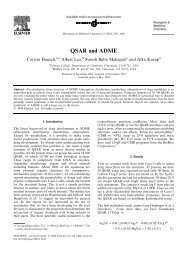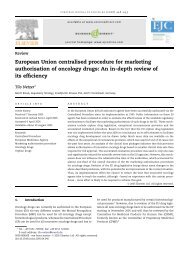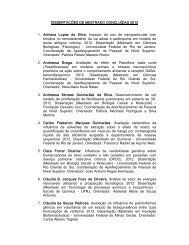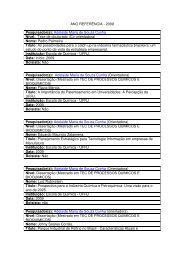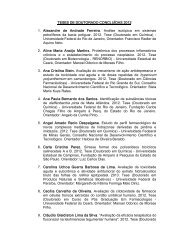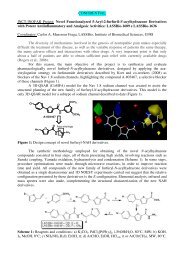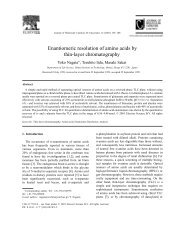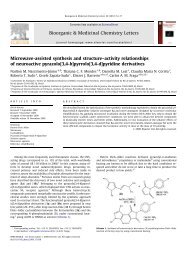Annual Activities Report 2011 - INCT-Inofar - UFRJ
Annual Activities Report 2011 - INCT-Inofar - UFRJ
Annual Activities Report 2011 - INCT-Inofar - UFRJ
Create successful ePaper yourself
Turn your PDF publications into a flip-book with our unique Google optimized e-Paper software.
<strong>Annual</strong> <strong>Report</strong> <strong>2011</strong> | <strong>INCT</strong>-INOFAR<br />
38<br />
Highlights<br />
Many of the non-polar aliphatic amino acids, such as glycine, alanine, valine, isoleucine, leucine and<br />
methionine, differ solely through homologation or inversion of the positions of methyl groups (Figure 1B).<br />
For example, isoleucine has one homologated methyl in comparison to valine. Moreover, alanine is the<br />
methyl-homologue of glycine.<br />
Morphine was first described in 1805 by the German pharmacist Sertürner, 5,6 although it was originally<br />
isolated by Seguin and Courtois in 1804. 7 Sertürner described the isolation of a white alkaline solid with<br />
hypnotic properties, which he called morphine after the Greek god of sleep Morpheus. 5,6 The complex<br />
chemical structure of morphine was fully elucidated by Sir Robert Robinson in 1925, 8 who was awarded<br />
a Nobel Prize in Chemistry in 1947. Morphine provides a good illustration of the importance of methyl<br />
groups and how their simple introduction or removal may significantly alter the pharmacological activity of a<br />
bioactive compound, leading to different pharmacokinetic and pharmacodynamic profiles.<br />
Studies of the structure-activity relationships of morphine revealed that removal of the methyl group attached<br />
to the sp 3 nitrogen of its benzylisoquinoline ring to generate normorphine causes ca. 6-fold reduction in in<br />
vivo analgesic activity (morphine ED 50<br />
= 4.8 mg/kg and normorphine ED 50<br />
= 31.5 mg/kg in mice). 9 On the<br />
other hand, the simple O-methylation of morphine’s phenolic hydroxyl group at C-3 generate codeine (Figure<br />
1C) 10 reduces its receptor affinity by 200-fold, 11 demonstrating that methyl groups may also have a negative<br />
influence on activity. In this case, the presence of an additional methyl group of codeine reduces its interaction<br />
with opioid receptors because the phenolic hydroxyl group of morphine is responsible for the hydrogen bond<br />
interactions with the target receptor site (Figure 1C). 12,13 Despite being 200-fold less potent in vitro, codeine is<br />
only 3-fold less potent than morphine in vivo (codeine ED 50<br />
= 14.5 mg/kg in mice), 9 enabling this drug could<br />
be used for the treatment of moderate pain, cough, and diarrhea. 14<br />
The importance of naturally methylated products as prototype substances for the development of new drugs<br />
can be observed in the history of the discovery of compactin. 15 This hexahydronaphthalene derivative is the<br />
source for antilipemic agents known as statins; in fact, the statin atorvastatin (Lipitor®) is currently the bestselling<br />
drug worldwide (Figure 1D). 16 All of the statins structures contain two methyl groups in an isopropyl<br />
group connected to the central heterocyclic system. These methyl groups are important for activity due to their<br />
involvement in hydrophobic interactions with Leu562, Cys561 and His752, which create an entropic gain<br />
in the interaction with the target receptor. The removal of the methyl groups leads to an 18-fold reduction in<br />
potency, as shown in initial structure-activity relationship studies with certain pyrrole derivatives. 17<br />
Omeprazole (Losec®), is a pyrimidinyl-benzoimidazol derivative with important antiulcer properties, was the<br />
first selective gastric H + -K + -ATPase inhibitor, which are also referred to as proton pump inhibitors (PPIs)<br />
(Figure 1E). 18 Structure-activity relationship studies of omeprazole showed that the introduction of methyl<br />
groups into the pyridine ring, due to their electron-donating effects, is beneficial for activity and increases its<br />
potency against H + -K + -ATPase. The introduction of methyl groups into these inhibitors allows fine tuning




